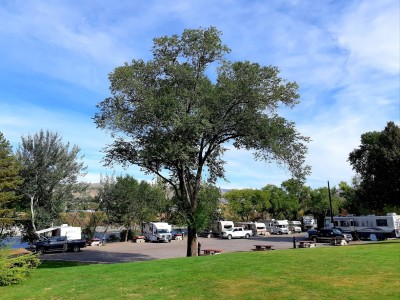Clinton near 70 Mile House and Cache Creek, Photo Destination BC
Cache Creek
Cache Creek is located in Gold Country in the Thompson Okanagan region and can accurately be described as a bustling oasis town in the midst of cactus, tumbleweed and a desert-like climate. Legend has it that the town got its name when travelers began to hide their ‘cache’ in the nearby Bonaparte River while they rested. Whatever the story may be, the ‘cache’ has still not been found.
This is a town that celebrates the 50s and 60s and invites visitors to stop by and indulge in a freshly baked goody or an icecream and to enjoy the Farmer’s Market. Geocaching has become a popular pastime in Gold Country with planned events and a guide to assist you in your quests. Swimming, golfing, hiking, biking and other outdoor activities abound and popular Juniper Beach Provincial Park offers a place to cool off and explore the waters by kayak or canoe, do a spot of fishing or wildlife viewing.

Hoodoos in Gold Country near Cache Creek
Location
Cache Creek is located at the Junction of the Trans-Canada Highway 1 and Cariboo Highway 97 11 km (7 mi) north of Ashcroft, 83 km (52 mi) west of Kamloops and 115 km (71 mi) north of Merritt.
A Step Back in Time
The name Cache Creek goes back to the fur trade era when First Nations were the only inhabitants of the BC Interior along with the occasional fur trader. It is thought that cache came from the storage or cache used by fur traders to store furs, fish and supplies. Such caches were commonly used by both First Nations and white traders.
Cache Creek was of little importance during the early years of the gold rush, however farmers and ranchers began to settle in the region.
The building of the road brought about Cache Creek’s first hotel or stopping house in 1863 or 1864. It was built by James Orr at Rattlesnake Hill about a mile below the bridge over the creek. In 1865, Semlin and Parke bought him out, moved the hotel to Cache Creek proper, and renamed it Bonaparte House.
Charles A. Semlin arrived in B.C. from Ontario in 1862, and in 1864 he was working for the Cornwall brothers. He ran the Bonaparte House from 1865 to 1968 with Philip Parke, who had also worked for the Cornwalls. At that time, Parke sold his interest to Sandford and started ranching near Hat Creek. The Parke family still operates this ranch today, which includes Donald McLeans’ original ranch and roadhouse.
Charles Semlin gave up his part of the hotel in 1870 when he purchased James Campbell’s Bonaparte Ranch just east of Cache Creek. The Semlin Ranch became a well-known establishment in B.C., especially after Charles Semlin turned to politics. First elected to the Provincial Legislature in 1872, he served the Yale riding continuously to 1900. In 1882, he became leader of the opposition and finally served as Premier of B.C. from 1898 to 1900.
Cache Creek became an important station on the Cariboo Road because of a short-lived gold rush on the Big Bend of the Columbia River in 1866. To facilitate access into the region, a wagon road was built from Cache Creek to Savona’s Ferry on Kamloops Lake. From there, miners could take a paddle wheeler to Seymour Arm of Shuswap Lake, then overland to the Columbia River. From then on, Cache Creek was the place that passengers and mail transferred to the stage for Kamloops and the Okanagan.
By the 1870s, the interior was beginning to fill up with settlers and the provincial government became concerned over education for the children. A report in 1871 recommended that a boarding school for the district be built at Kamloops. However, Charles Semlin’s political influence secured this school for Cache Creek, his own home. As more schools opened in the interior, the enrollment dwindled until the school was finally closed in 1890.
Cache Creek remained an important station on the Cariboo Road through the 1870s and most of the 1880s. In 1871, the survey party of the Canadian Pacific Railway passed through Cache Creek however, the railway was eventually to reduce the town to relative unimportance after Ashcroft was chosen as the railhead for the Cariboo Road in 1885. Cache Creek as a town had to wait for the era of mass automobile traffic after World War II.
Cache Creek and Nearby Accommodations
British Columbia Lodging and Campgrounds Association Members
List
Map



